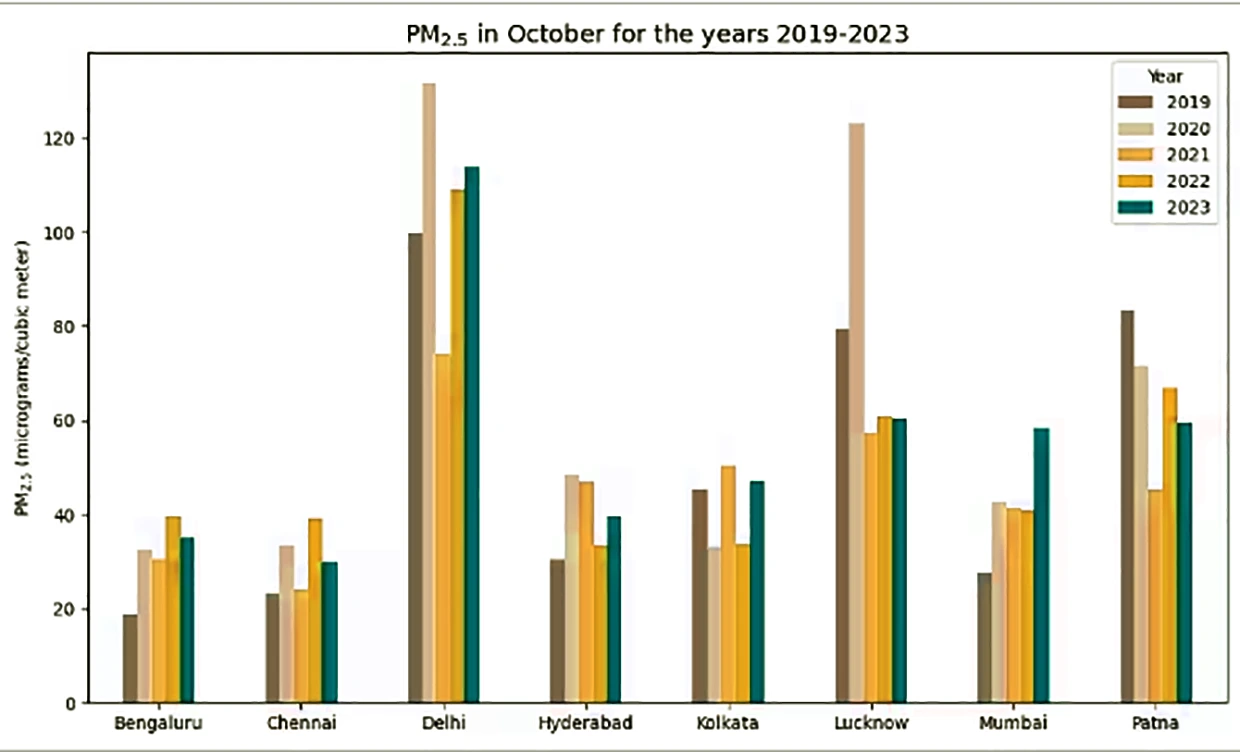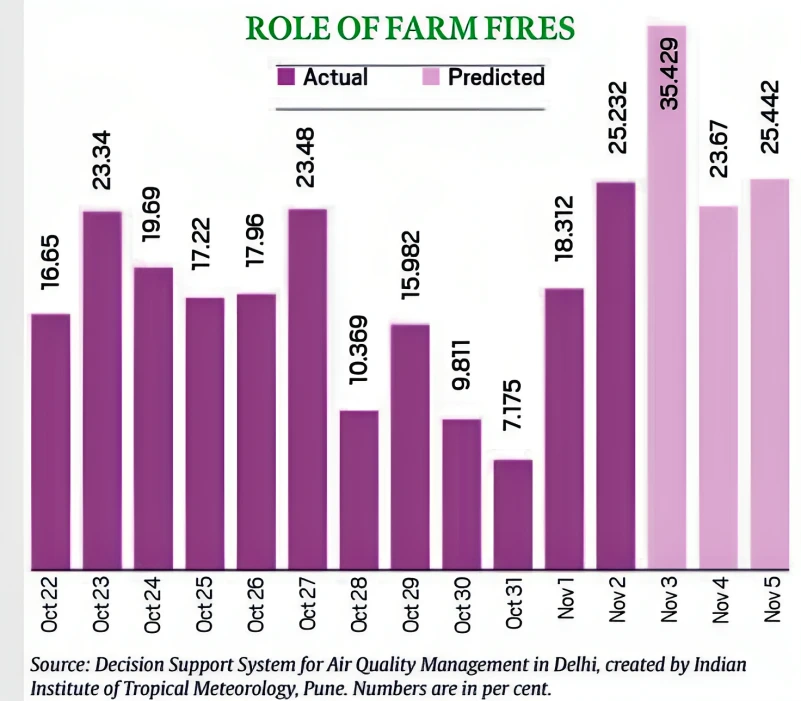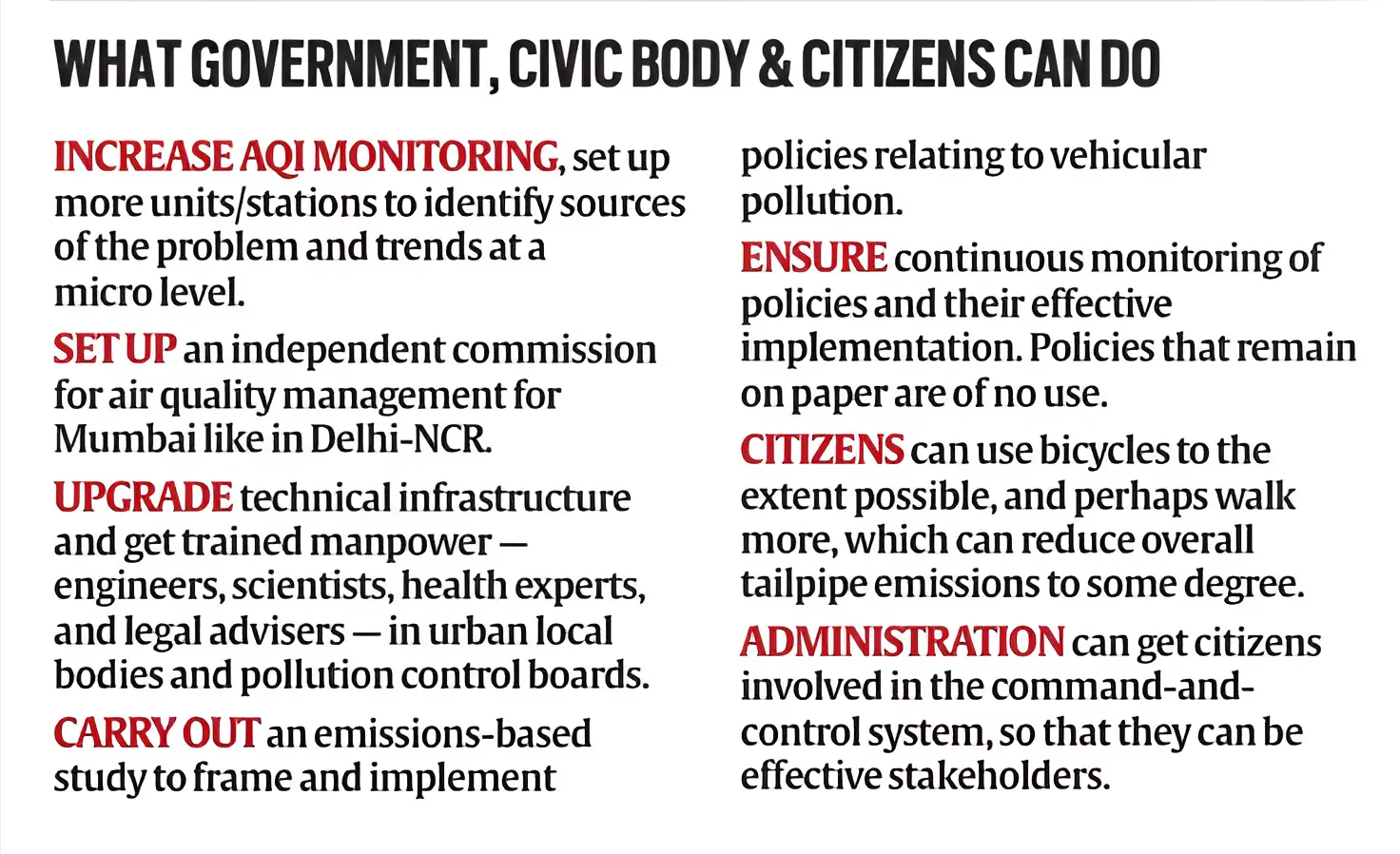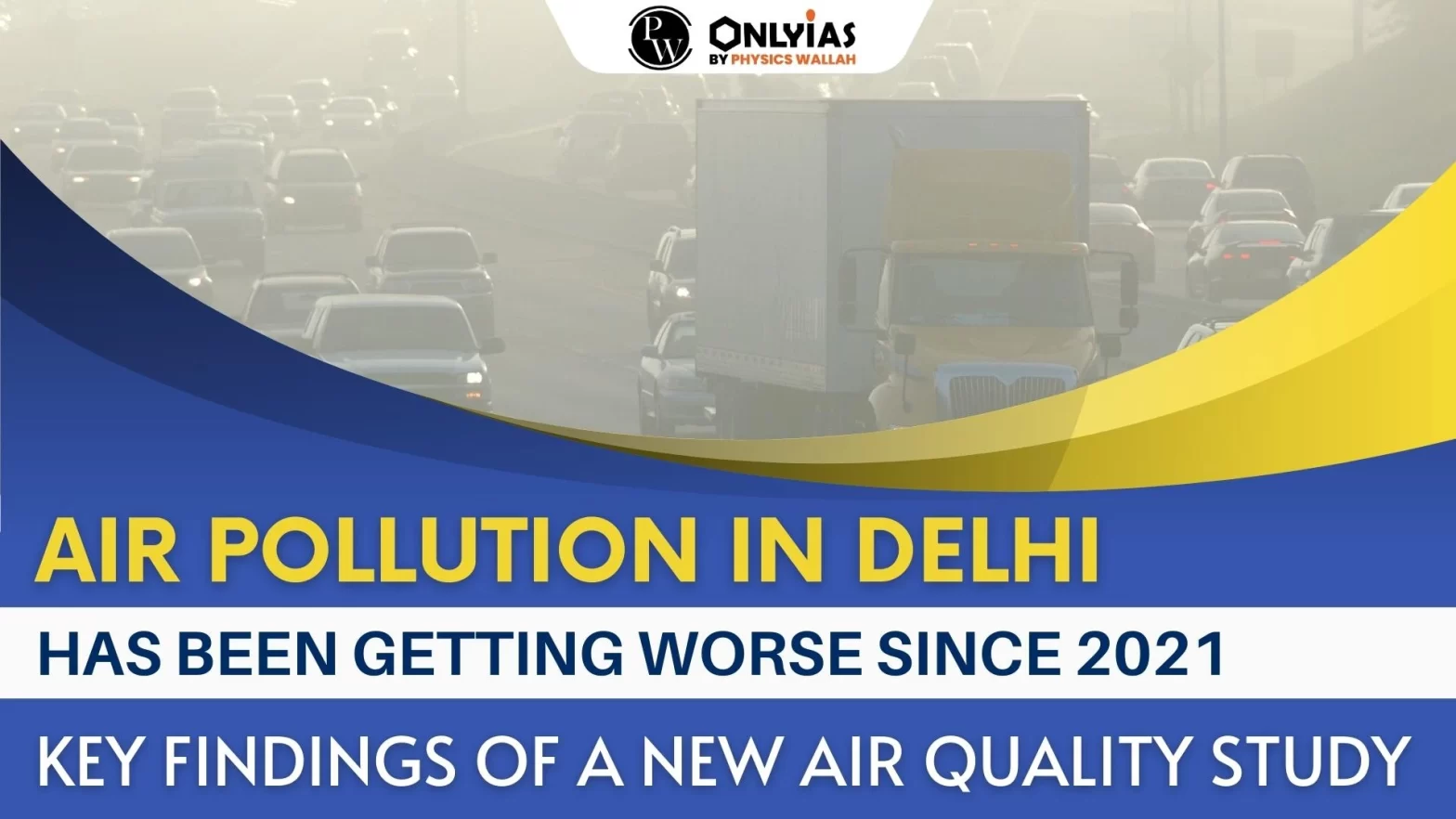Context:
What are the key findings of a recent air quality study regarding air pollution in Delhi?
- It involved an examination of PM 2.5 levels in cities like Delhi, Mumbai, Hyderabad, Kolkata, Lucknow, Patna, Bengaluru and Chennai.
- Out of the eight major state capitals in India that face an air pollution crisis, Delhi had the highest Particulate Matter (PM) 2.5 level in October for the past five years.
- Since 2021, the city has witnessed a consistent rise in PM 2.5 levels which increased by 4.4% in October 2023 as compared to last year.
- Delhi’s air quality has plummeted to hit the ‘severe’ category to reach 476 in the AQI.

Also Read: Mumbai Air Pollution
How does air pollution in Delhi impact?
- Health: Acute effects like burning eyes, irritation of nose and throat, cough, and feeling of choked breath.
- Serious harms include heart attacks and brain strokes, which are provoked when atherosclerotic plaques in blood vessels are disrupted by the pollutants, thereby triggering blood clots.
- Exposure during pregnancy increases the risk of stillbirths, neonatal deaths, low birth weight babies, and birth defects.
- Children chronically exposed to air pollution have repeated respiratory infections, susceptibility to asthmatic attacks, lower learning ability, and impaired physical growth.
- A recent report of the Air Quality Life Index (AQLI) estimated that Indians were losing 5.3 years of life expectancy on average due to the health effects of air pollution.
- Researchers estimated that people in Delhi lose close to 12 years because of the poor air they breathe.
- Economic growth: It leads to reduced worker output, lower consumer footfall in consumption-led services, hampered asset productivity, and a surge in health expenses and welfare allocations, especially in the productive age groups.
- A report by Greenpeace Southeast Asia and the Centre for Research on Energy and Clean Air According to the study, air pollution has an economic cost of $2.9 trillion, about 3.3 per cent of the world’s GDP.
- As per the report, the costs of poor air quality were manifested in six distinct ways: (i) lower labour productivity, (ii) lower consumer footfall, (iii)lower asset productivity, (iv)increased health expenses, (v) welfare losses, and (vi) premature mortality.
- Impact on Services sector: Even in indoor jobs such as those in call centres, air pollution takes a toll on productivity.
- As per the paper ‘The Effect of Pollution on Worker Productivity: Evidence from Call-Center Workers in China’, for each 10-unit increase in the air pollution index (API) for each city, worker productivity, measured by the number of calls handled, fell by 0.35%.
- Poor air quality impeded the performance of otherwise highly productive employees as much as it did of less productive workers.
- Environment: Air pollution, particularly sulphur and nitrogen emissions, as well as ground-level ozone, affects the ability of natural ecosystems to function and grow.
- For example, harmful concentrations of pollutants directly enter drinking water through groundwater seepage.
- Air pollution also diminishes the ability of the ecosystem to capture carbon—a role that it plays in climate change mitigation.
About Particulate Matter (PM) 2.5:
- Sized at just 2.5 micrometres, which is around 3% of the diameter of a human hair, it can easily enter the circulatory system of humans through the nose and throat.
- PM 2.5 is one of the most harmful atmospheric pollutants.
- PM 2.5 particles can cause chronic diseases such as asthma, heart attack, bronchitis, and other respiratory problems.
- In Delhi-NCR, PM2.5 concentrations exceeded the government-mandated 60 micrograms per cubic metre limit by seven to eight times.
- It was 80 to 100 times the healthy limit (5 micrograms per cubic metre) set by the WHO.
Air Quality Index (AQI): It is a tool for effective communication of air quality status to people in terms that are easy to understand.
- Category of AQI: Good, satisfactory, moderate, poor, very poor, and severe.
- Factor: Each of the categories is decided based on the ambient concentration values of air pollutants and their likely health impacts (known as health breakpoints).
|
What factors contribute to air pollution in Delhi?
- Stubble burning: There is a surge in stubble burning across neighboring states Punjab and Haryana.
- According to Indian Agriculture Research Institute Data, nearly 40 per cent of all burning events in the state, 5,140 out of a total of nearly 12,800 documented events since September 15, have happened in the first three days of this month.
- Northwesterly winds carry stubble-burning smoke from Punjab and Haryana into Delhi-NCR.
- According to data from the Indian Agricultural Research Institute (IARI), the fire count in Punjab has been more than 1,000 over the past five days.
- Industrial Pollution: Delhi has the highest cluster of small-scale industries in India.With as many as 3,182 industries located across the Delhi-National Capital Region (NCR), industrial pollution adds about 18.6 percent to the poor air quality.

- Vehicular emissions: The emission inventory and source apportionment studies suggest that on-road vehicular exhaust emissions account for nine to 38 percent of PM2.5 emissions in the capital.
- Construction: Fine dust from construction activities is a significant contributor to the poisonous mixture referred to as ‘smog’.
- According to Delhi Pollution Control Committee (DPCC) officials, 30 percent of air pollution in the territory is caused by dust from construction sites.
- The outskirts of NCT have roughly 360 brick kilns, mostly in the Jhajjar, Faridabad, and Ghaziabad regions.
- Weather conditions: Calm conditions, with very slow winds, in Delhi, have been making it difficult for pollutants to disperse.
What are the sources of air pollution in Delhi?
- Line sources: Vehicles
- Point sources: Power plants, factories
- Area sources: Garbage dump sites, sewage treatment plants
- Natural sources: Forest fires, volcanic eruptions
- Diesel fuel emissions, and road and construction dust
- Household air pollution comes from the use of biomass fuels and open fire-cooking stoves.
Pollutants that are monitored for air quality:
- PM 10 and PM 2.5, nitrogen dioxide, Sulphur dioxide, carbon monoxide, ozone, ammonia, and lead.
|
Graded Response Action Plan (GRAP):
- GRAP is a set of emergency measures implemented in the Delhi-NCR region to prevent deterioration of air quality once it reaches specific threshold levels.
Stages in GRAP:
- Stage 1 (Poor AQI – 201 to 300)
- Stage 2 (Very Poor AQI – 301 to 400)
- Stage 3 (Severe AQI – 401 to 450)
- Stage 4 (Severe + AQI – More than 450)
Stage 3 of the Graded Response Action Plan (GRAP):
- It is activated when the AQI turns ‘Severe’ (AQI 401-450).
- It entails the total stoppage of non-essential construction and demolition work with the exception of essential government projects, mining, and stone crushing.
- It also includes a ban on entering light commercial vehicles registered outside Delhi and diesel trucks for non-essential purposes.
|
How has the government responded to air pollution in Delhi?
Graded response plan: The Commission for Air Quality Management (CAQM) has announced the implementation of the third stage of its graded response plan. The CAQM directed authorities in the NCR to increase parking fees to discourage private transport and enhance the services of CNG or electric buses and metro trains amid a likely increase in pollution levels.
-
- The government brought the Commission for Air Quality Management(CAQM) Act 2021 under which CAQM was created for dealing with pollution in the National Capital Region and Adjoining Areas.
- 15-point winter action plan: It was announced to deal with air pollution in the national capital during winter.
- Odd-Even Scheme: it was introduced in 2016 by the government to control vehicular pollution and bring down increasing particulate matter levels.
- Red Light On Gaadi Off” campaign: It aims to reduce vehicular pollution in the national capital by encouraging drivers to switch off their vehicles while waiting for traffic lights to turn green.
Supreme Court interventions to tackle air pollution in Delhi
- Mehta Case 1998: The court ordered that public road transport in New Delhi be run on compressed natural gas or CNG, and not on fossil fuels, by April 2001.
- Subash Kumar Case: The Court recognized the right to a wholesome environment as part of the fundamental right to life under Article 21.
- The court passed orders in 2016 banning the sale and use of firecrackers in Delhi.
- In 2018, it allowed the sale and use of ‘green firecrackers’ in Delhi.
- The SC directed the state governments to provide farmers with machines that they can hire to remove stubble.
- The SC asked the Delhi government to install smog towers and ordered it to use smog guns at construction sites.
- In October 2020, the court set up the Madan B. Lokur Committee to oversee the steps taken to prevent stubble burning.
|
What are the suggested ways forward to address air pollution in Delhi?
- Personal protection measures: Air purifiers may be used to protect persons who are confined in closed spaces.
- Masks of high quality (N95) offer protection against many pollutants.
- It is best to avoid or reduce outdoor activity during smoggy periods. Breathing exercises help to maintain lung function.

- Clean transport: cessation of stubble and garbage burning, good construction practices, and efficient debris disposal.
- Improving DPCC capacity: The Delhi Pollution Control Committee (DPCC) should be strengthened as an institution and vacant positions in the committee should be filled.
- Integrated clean public transport: Electric vehicles, increased use of public transport in place of personal vehicles, and rapid transition to renewable energy sources from fossil fuels supported by walking and cycling infrastructure are needed.
- Checking Household air pollution: It needs to be addressed through the substitution of biomass with natural gas and better ventilation of kitchens.
- For example: schemes such as Ujjwala are a step in the right direction by the government.
- Clean energy transition across industry and households: This is achieved through 100 per cent waste collection and segregation, recycling, and remediation of legacy waste at dump sites.
- It is necessary to scale up the stringent multi-sector action plan across the entire NCR region and beyond to minimize the regional influence on local air pollution in Delhi.
Conclusion:
The recent air quality study highlights the alarming escalation of air pollution in Delhi, with severe health, economic, and environmental implications, underscoring the urgent need for comprehensive and sustained measures to address the multifaceted sources of pollution in the region.
| Prelims Question (2016)
In the cities of our country, which among the following atmospheric gases are normally considered in calculating the value of Air Quality Index?
1. Carbon dioxide
2. Carbon monoxide
3. Nitrogen dioxide
4. Sulfur dioxide
5. Methane Select the correct answer using the code given below.
(a) 1, 2 and 3 only
(b) 2, 3 and 4 only
(c) 1, 4 and 5 only
(d) 1, 2, 3, 4 and 5
Ans: (b) |
![]() 4 Nov 2023
4 Nov 2023




